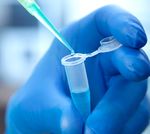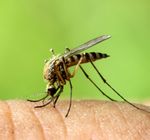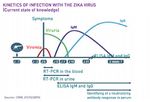Dengue Fever, Chikungunya and the Zika Virus - Eurofins Biomnis
←
→
Page content transcription
If your browser does not render page correctly, please read the page content below
#57
Focus
International
Dengue Fever, Chikungunya
and the Zika Virus
Arboviruses are a group of virus that can be southern regions of mainland France and
transmitted between animals and humans, on the island of Réunion, Aedes albopictus
and they are common to humans and many provides the sole vector for transmission.
vertebrates (mammals, birds, reptiles, Transmission
amphibians). There are over 500 species of
Dengue Fever, Chikungunya and the Zika
arbovirus, sub-divided into approximately
virus are all transmitted in the same way.
10 different families, including Togaviridae,
Flaviviridae, Reoviridae, Rhabdoviridae, Human to human transmission takes place
and Bunyaviridae. These viruses have RNA by mosquito vector in urban areas during
with a very heterogeneous structure and are epidemics: the mosquito picks up the virus
transmitted via bites from hematophagous when it bites a carrier, and then transmits it
arthropods such as mosquitoes, sandflies, to a healthy person with another bite. The
ticks and mites (arbovirus is short for mosquito bites people outside their homes
arthropod-borne virus). throughout the day, with peak activity at
dawn and dusk. The mosquitoes live in
Chikungunya urban areas and lay their eggs in pools of
stagnant water (250 eggs every 2 days),
This disease was first described in Tanzania where they develop into larvae. The eggs
in 1952. It is caused by an arbovirus of the are resistant to the cold in winter and hatch
genus Alphavirus from the Togaviridae family. when weather conditions improve.
It was then also described in Africa, Southeast
Aedes albopictus is spreading globally; it
Asia, the Indian subcontinent and the Indian
has adapted to both tropical and temperate
Ocean. Finally, it was first described in Europe
climates.
in 2007, in Italy.
Chikungunya means "to become contorted" in Clinical presentation
the Kimakonde language (spoken by a tribe in There is a short incubation period, which
Focus 57-INTGB - May 2018
south east Tanzania) and reflects the severity lasts an average of 47 days (1-12 days), after
of the pain that can be associated with this which patients develop sudden high fever
infection. of > 38.5 °C, headache, myalgia or intense,
Globally, the virus is transmitted by female debilitating joint pain, potentially associated
mosquitoes of the species Aedes albopictus with conjunctivitis, maculopapular rash,
(tiger mosquito) and Aedes aegypti, but in itching, nausea, mild bleeding (gingivitis,
1/6epistaxis). It should be noted that cases can < D5: RT-PCR
be asymptomatic (13% of cases on Réunion D5-D7: RT-PCR and serology
during the 2007 epidemic). The acute phase
D7: serology only
(viremic phase during which the disease can
be transmitted by a bite) lasts 5-10 days. It is Chikungunya: major outbreaks
followed by fatigue, weight loss, anorexia with The first significant outbreak of the disease
dysgeusia, hair loss, skin disorders (patches was reported in the Congo in 1999/2000.
of dyschromia, xerosis and itching), and Since 2005, there has been an epidemic in
memory impairment. Course of the disease the Indian Ocean (with cases imported to
can be rapidly favourable, or recovery may Europe); in 2007 there was an outbreak in the
be slow and marked by significant asthenia. north east of Italy, and in late 2013-2014 there
Relapses affecting the joints, with or without was a major epidemic in the West Indies and
fever, can occur (but the patient is not Guyana and, in 2014 there were cases in the
contagious). In 30-60% of cases, the disease south east of France and in Corsica.
progresses to a chronic phase characterised Dengue Fever
by persistent arthralgia and partial disability;
this phase can last from a few weeks to This disease is caused by the dengue
several months. Some complications have virus, an arbovirus also transmitted by
been observed, such as high fever, extensive mosquitoes of the Aedes genus. The virus
vesiculobullous lesions, and involvement belongs to the Flavivirus genus in the
of the brain (meningoencephalitis), liver family Flaviviridae.
(hepatitis), kidneys (acute renal failure), or Cases of dengue fever appear to be on the
the heart (myocarditis). One possible case rise. There are 4 known serotypes (D1 to
of mother-to-child transmission has been D4), and they do not provide crossimmunity
described on Réunion. (it is possible for one person to have 4
The mortality rate is 3.6 per thousand. Patients infections in their lifetime).
have lasting immunity once recovered. There Serotypes 1, 2, and 3 are more prevalent
is no treatment or vaccine available. in Asia and the West Indies/Guyana, and
serotypes 1 and 2 are more common in Africa.
Biological diagnosis The 1977-78 epidemic in the Indian Ocean
The test to be performed depends on when (Réunion) was caused by serotype 2, and the
the sample is taken in relation to the date on 2004 and 2010 epidemics were caused by
which symptoms first appeared (see Fig. 1): serotype 1 and serotype 3 respectively.
Fig. 1: Sequence of the appearance of biological markers
IgM IgG
Focus 57-INTGB - May 2018
D-7 D-2 0 D5 D7-D10 D30 3-6 months
Culture, PCR
2/6Epidemiology from Dengue 1 followed by Dengue 2). The
Dengue fever is hyperendemic in the West warning signs for complications (or serious
Indies and Guyana, as well as in South forms of dengue fever) are abdominal pain,
America and some countries in Africa persistent vomiting, oedema, bleeding
and Asia. It has also emerged in French mucosa, lethargy or agitation, hepatomegaly,
territories in the Pacific Ocean and in the thrombocytopenia and increased haematocrit
south east of mainland France. levels.
2010 in the French departments of Biological diagnosis
Alpes-Maritimes and Var: 2 cases of
Diagnosis of the primary infection is based
local transmission of dengue fever (+2
on the detection of the viral genome by RT-
cases of Chikungunya)
PCR ( if carried out within the 7 first days)
2013 in the Bouches du Rhône and/or by IgM and IgG serology ( from the
department: 1 case of local fifth day of infection)
transmission of dengue fever
The serology should be interpreted on two
2014: 4 confirmed cases of local
samples, one of which must be drawn ≥15
transmission of dengue fever: 2 in the
d. This is due to the fact that IgM tests have
Bouches du Rhône and 2 in the Var
of lack of specificity (false positive cases).
2015: 6 cases of local transmission of
dengue fever in Languedoc Roussillon. It is important to pay attention when
interpreting secondary dengue infections
Clinical presentation (patients previously infected with serotype
The infection is asymptomatic in 50 to 85% D1 dengue will already have IgG antibodies
of cases. When symptoms do occur, they when infected with serotype D2).
are extremely variable and the course of
Immunity is present for a given serotype
the disease is unpredictable. There is an
but it does not protect from infections with
incubation period of 4-10 days, after which
other serotypes.
onset of the disease is sudden and severe,
characterised by high fever, widespread pain, Diagnostic strategy
rash, fatigue, and gastrointestinal symptoms from D0 to D5: PCR only
(loss of appetite, nausea, vomiting). However, from D5 to D7 inclusive: PCR and
in some people the disease can take on a serology
haemorrhagic form or cause dengue shock
after D7: serology only
syndrome. The risk of contracting a more
serious form of the disease is higher in cases Testing for the NS1 antigen is only indicated
where there is a higher viral load or where in regions where there is an outbreak of the
a patient contracts consecutive infections disease and from D0 to D5; a negative NS1
caused by different serotypes (the highest antigen test must be confirmed by PCR and/
risk of a serious form of the disease comes or serology.
Kinetics of the virus and antibodies during infection by the dengue virus
Focus 57-INTGB - May 2018
3/6Treatment This plan is active during the mosquito
There is no specific treatment for dengue season from 1 May to 30 November.
fever, but the symptoms can be treated. Finally, the InVs [French Institute for Public
A vaccine (Dengvaxia®) was granted Health Surveillance] collects all positive
marketing authorisation in December diagnoses from the laboratories performing
2015 in Mexico, the Philippines, and Brazil these analyses.
(and this marketing authorisation is being In 2014: 1,490 suspected cases in 18
extended rapidly to other countries). The departments, including 446 confirmed
vaccine is for the prevention of the 4 dengue cases of Chikungunya (all imported cases);
fever serotypes, for use in endemic areas 166 confirmed cases of dengue fever (all
only, and in people aged 9 to 45 years. imported), 6 co-infections and 4 cases of
Monitoring plan local transmission of dengue fever.
The plan for monitoring dengue fever is From 1 May to 27 November 2015:
based on mandatory immediate reporting 127 confirmed cases of imported dengue
to the ARS [French regional health fever; 30 confirmed cases of imported
authorities] (if 2nd positive serum IgM test). Chikungunya; 6 confirmed cases of local
transmission of dengue fever.
A regional plan for enhanced monitoring
has been implemented in the French The Zika virus
departments where the mosquito is
The Zika virus is an enveloped Flavivirus
established.
with a singlestranded RNA genome.
There are two strains of the virus: one
African strain (with two substrains) and an
Asian strain. It was first isolated in 1947
in a monkey in Uganda (in the Zika forest
from which it takes its name), and then in
humans in 1952 (Uganda, Tanzania). It
has been circulating in Africa and Asia for
a long time. There have been epidemics
in Micronesia (2007), French Polynesia
(2013) and New Caledonia (2014). Like
dengue fever and Chikungunya, the
vector is a mosquito of the genus Aedes.
In addition to transmission by mosquito
vector, there is evidence that sexual and
perinatal transmission of the Zika virus is
also possible, as well as transmission via
blood transfusion.
Current and recent epidemics
There was an epidemic of the Zika virus in
Brazil in May 2015. Enhanced surveillance
was put in place in the West Indies and
Guyana. In early December 2015, cases
of what was presumed to be the Zika
virus were described in Martinique. On
Focus 57-INTGB - May 2018
15 December 2015, the first case of Zika
was confirmed in Guyana, followed by
confirmation of another 10 cases, all of
which were imported. On 22 December
2015, two cases of local transmission
Data from enhanced monitoring in mainland France in 2014 and 2015
4/6were confirmed in Martinique, followed by autoimmune complications (purpura).
five more in Guyana. In early 2016, the If the Zika virus is contracted during
epidemic had reached Guadeloupe and pregnancy, it can also cause intrauterine
the northern Caribbean islands. brain development abnormalities and
microcephaly (observed in Brazil and
Clinical presentation Polynesia among the newborn babies of
The infection is asymptomatic in 70-80% of mothers who were infected during the first
cases. In cases that do develop symptoms or second trimester of pregnancy).
there is an incubation period of 3 to 12 In patients who have recently returned
days, after which patients experience from an epidemic area, the Zika virus is to
flu-like symptoms and a diffuse, itchy, be suspected in those presenting with a
maculopapular rash. The rash covers a maculopapular rash with or without fever,
large area and spreads downwards from even moderate fever, and at least two
the face to the extremities, remaining of the following symptoms: conjunctival
for about 6 days, predominantly on the hyperaemia, arthralgia, myalgia, in the
torso. Other symptoms include asthenia, absence of any other aetiology.
fever (or temporary low-grade fever),
arthralgia (lasting 3-5 days), headaches Arboviruses: comparison of clinical
with pain chiefly behind the eyes, symptoms
myalgia, and conjunctivitis. Although it (from Halstead SB et al, A J Trop Med Hyg
is not immediately serious, the infection and the booklet of the Yap State Department
can develop neurological complications: of Health Service)
Guillain-Barré syndrome, 2-23 days
after the viral infection, encephalitis,
meningoencephalitis, optical neuritis or
Dengue
Symptoms Chikungunya Zika
fever
Fever ++++ +++ +++
Myalgia / arthralgia +++ ++++ ++
Maculopapular rash ++ ++ +++
Pain behind the eyes ++ + ++
Conjunctivitis 0 + +++
Enlarged lymph nodes ++ ++ +
Focus 57-INTGB - May 2018
Hepatomegaly 0 +++ 0
Leukopenia, thrombocyto-
+++ +++ 0
penia
Haemorrhagic events + 0 0
5/6Diagnostic biologique Conclusion
There is currently an epidemic of Zika
virus in the French West Indies. The con-
ditions for an epidemic in mainland France
are present, and there is a real risk from
May to November. In the light of the pres-
ence of transmission vectors and influx
of passengers, the French Public Health
Council [Haut Conseil de la Santé] has
concluded that "the risk of transmission of
Diagnosis is based on using RT-PCR to Zika virus
detect the viral genome. is high in the French departments in
In the blood: viremia is transient the Caribbean (Guyana, Guadaloupe,
and viral load is low and short-lived Martinique) where the vector Ae. aegypti
(0 to 7 days after the onset of clinical is present, and this risk concerns the
symptoms); whole of the population residing or
In saliva: the virus is present and can holidaying there;
be detected for the same period of time is real in Réunion (presence of Ae.
as in the blood; the value of the viral albopictus) and in Mayotte (presence of
load is unknown; Ae. albopictus and Ae. aegypti), and this
In urine: the virus is present up to 10 risk concerns the whole of the population
days after onset of symptoms, and the residing or holidaying there;
viral load is higher. is real in the departments of mainland
Anti-Zika IgM and IgG serology can France where Ae. albopictus is
currently be performed at the National established; this risk exists during its
Reference Centre [CNR] (Marseille) with period of activity from May to November,
whole virus, but there are cross-reactions particularly in the event of virus
Focus 57-INTGB - May 2018
with other Flaviviruses, and this test does circulation in the Caribbean. This risk
not differentiate between dengue virus and concerns the whole of the population
Zika (serology tests positive for Flavivirus; residing or holidaying there."
if the neutralisation test is negative for Carole Emile, based on a statement by Véronique
dengue virus, it may be positive for Zika by Jacomo, Biomnis Lyon (February 2016)
default). The NRC recommends monitoring
serology at 1 month.
www.biomnis.com
6/6You can also read


























































